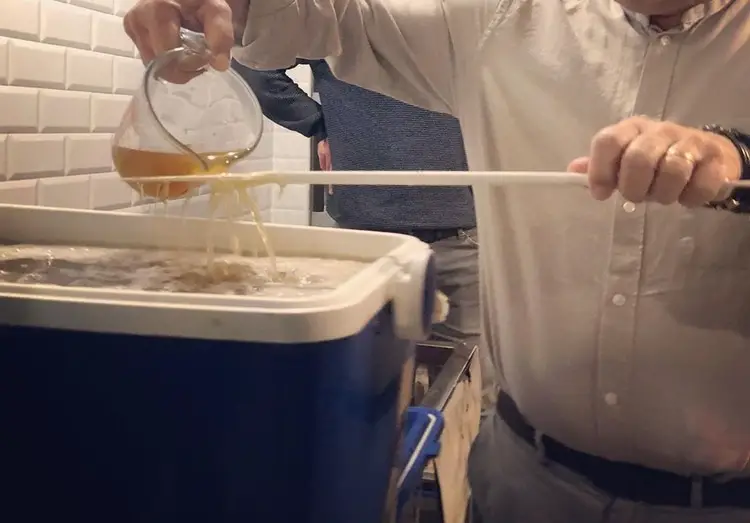For intermediate to advanced brewers, mashing is an integral step to making better beer in their pursuit of great beer. There is no mash without a clean vorlauf. Whether store-bought or homemade, mashing and extracting raw wort is key to the process.
So, what is vorlauf in beer brewing?
To vorlauf means to recirculate the wort through the mash bed. It’s a process in all-grain brewing happening after the mash and before the sparge. Vorlaufing clarifies the wort, catches bitter husks, and traps unwanted protein in the grain bed. It’s an easy operation taking anywhere from 10-40 minutes.
Vorlaufing is an essential element of wort production and I’m going to explain it to you in this article.
Should You Recirculate / Vorlauf Your Mash?
Vorlaufing clarifies the wort and gives you the cleanest possible wort as your base.
Husks can come through the screens, especially in homemade set-ups.
Husks taste bitter and add astringency to a boil.
The malt itself, aside from its modified starch and converted sugar holds a lot of protein.
Protein can give your beer mouthfeel and flavor.
Crystal clear wort holds in solution all the protein you need.
Also, look for a healthy cold break – as your wort cools, the trub (remaining solids, protein and hops) coagulates and rests gently on the bottom of your kettle, to be left behind as you rack into your fermenter.
Excess protein can cloud your beer and cause permanent haze problems later in the bottle.
Chill haze is one such phenomenon.
Your beer clouds up when it is cold, and clarifies as it warms.
It is not so detrimental to taste but affects your beer’s aesthetic.
How Long to Vorlauf?
Depending on the size of the mash and the clarity desired, the recirculation of the mash can last up to 40 minutes.
Some brewers rush a little, wanting to get on to various processes they prefer.
This is understandable.
All processes, large or small are equally important, else they wouldn’t be considered.
True, some brewers pick and choose which processes to keep and which to throw out.
This is a keeper.
The Set-up for a Vorlauf
Vorlauf is German for recirculation.
Let’s imagine I’m brewing 5 gallons of beer. This is the default brew volume for most of my discussions.
I have made a lauter-tun out of two 5-gallon plastic buckets.
I have drilled 1/8” holes in the bottom of one and set it inside of the other.
I installed a plastic spigot in the second to draw out the wort.
I mash in a 36-54 quart cooler with a clean tight seal.
I never sit on it nor use it for anything except brewing- not picnics, not even beer.
The seal must remain tight and flawless.
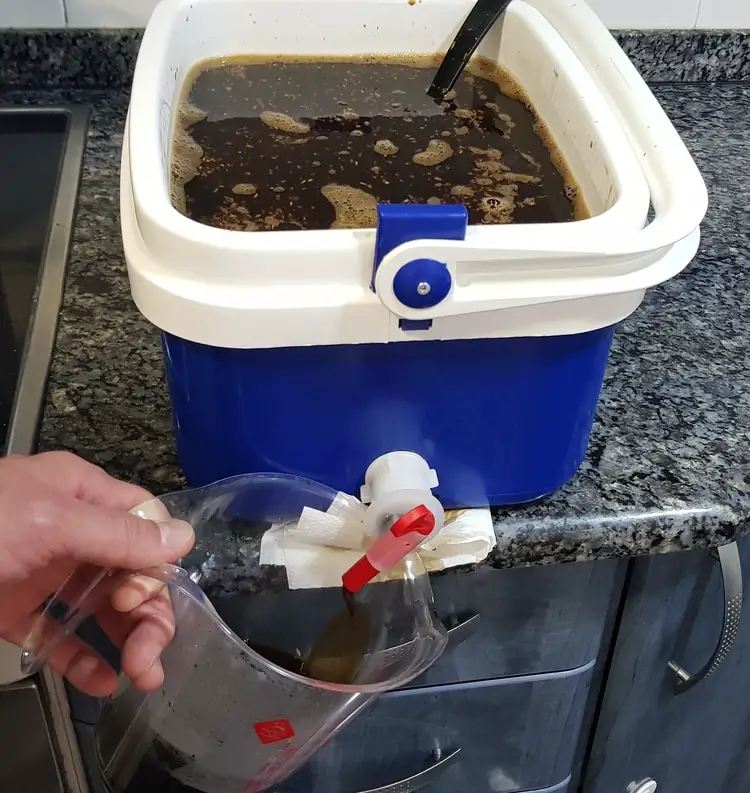
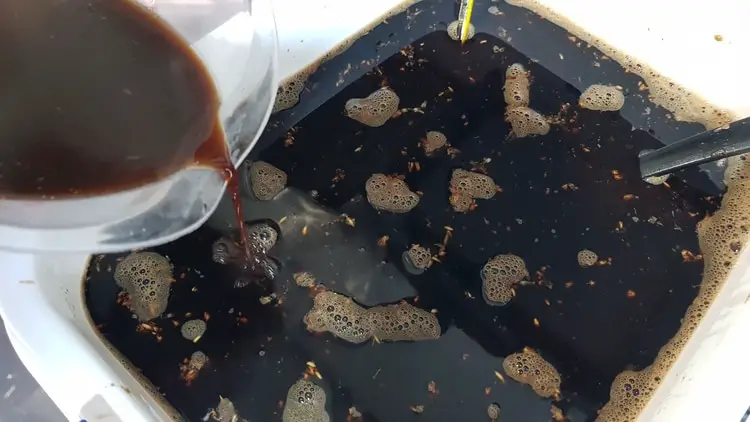
Using a large cup, like a 1-liter plastic beer mug or large measuring cup type apparatus, I scoop up the malt and lay it gently into the lauter-tun.
I have already heated my sparge water to 170˚ F (76° C).
I pour into the lauter-tun until it is about 1” above the spare holes.
This is called foundation water.
It keeps the mash loose, watery and keeps it from compacting.
Gently lay the mash in the lauter until the cooler is empty.
Note: for smaller set-ups (1 and 2 gallons), you may vorlauf through a strainer it may not matter, but ideally the mash should be in liquid otherwise it will become compacted.
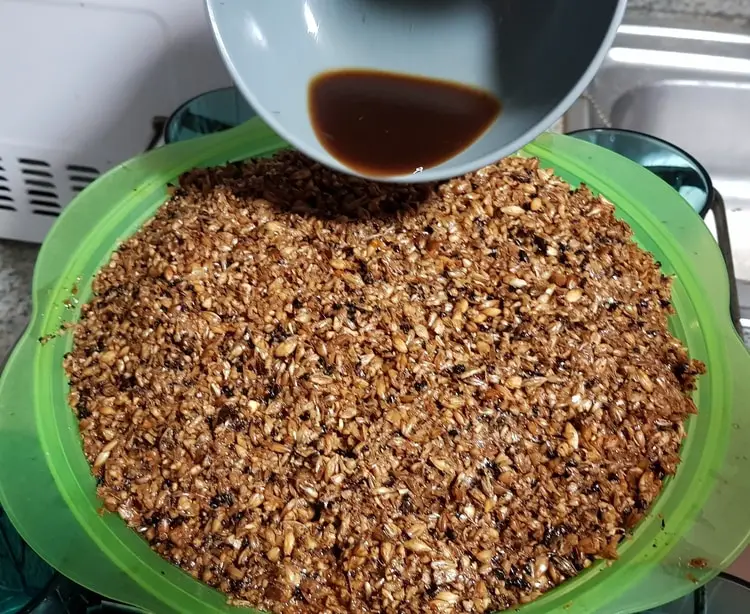
How To Do a (Good) Vorlauf
At this point, I begin running the wort out slowly into a small cup.
I had a 12-ounce plastic beer mug I used; exceedingly low tech.
I fill the cup and gently submerge the cup halfway into the mash and pour out the wort.
Repeat.
I do this about 20 times, about 10-15 minutes.
Note: Once the mash is converted, a temperature drop is OK. So take your time. We hope the sparge temp will bring it all up to 170° F (76° C).
Taking a small sample beer glass, I run out a sample of wort and hold it up to the sky.
I brewed outside.
Visually check for clarity.
It should be clear, if a little hazy.
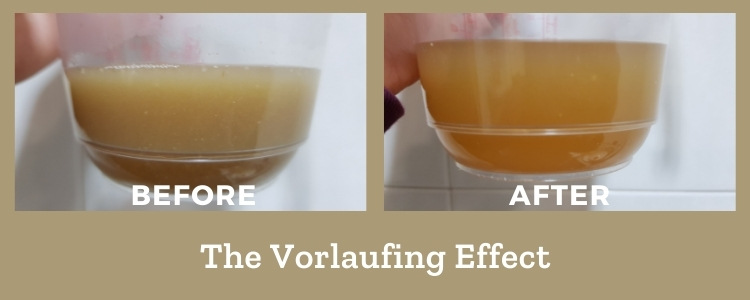
I would usually do this for about 30 minutes.
It wasn’t crystal clear but pretty close.
I drank beer, brewed with a buddy, blasted music, there was no chore to it.
Here’s a good example of how to do it in this Youtube video:
Too Much of a Good Thing
In a thorough vorlauf, especially with wheat beer for instance, you will get a thick layer of proteinous sludge on top of the mash.
The wort is perfectly clear but the sparge water will not run through!
There are two options.
- Make a cross in your grain bed with your brewing spoon.
- Second, you can stir the top 2-3 inches of the mash under, making sure there is a permeable grain bed on the surface, yet the protein stays on top.
Too Much Protein in The Kettle
Chill haze is one example of excess protein that risks complications.
Polyphenolic (astringency) compounds and fatty acids are two specific culprits.
These large particles reflect light making them visible in the beer.
Protein haze can develop into permanent haze, irreversibly so.
Protein in the wort is not bad per se.
It does add yeast nutrients and keep esters under control.
In excess it impacts clarity and head retention.
When these compounds become oxidized, they may produce aldehydes (bitter acidic compounds) with unpleasant off-flavors, including nice goaty, soapy, or tallowy flavors.
Vorlauf Manually or By Pump?
The method I described is basic and may be completed with simple household items.
There are pumps available to manage this process for you.
They would be simple centripetal pumps with food-grade fittings; miniature versions of what professional brewers use.
This is a fine option if you have a large budget.
Make sure your pump is food grade, has sanitary fittings, and can accept high temperatures.
For example this one by Northern Brewer: https://www.northernbrewer.com/products/northern-brewer-wort-pump
Vorlauf And BIAB
Brew in a bag (BIAB) makes all-grain brewing possible for many without the resources and physical space for traditional brewing.
Even if this is the case, I still recommend recirculating your raw wort from the mash.
It can be hard to do, especially if you are simply dangling a big wet bag of malt above your kettle for the duration of your sparge. Try to fashion a flat, pan-shaped strainer to rest over your kettle.
A typical bowl shaped is ok, but less ideal.
My main concern with BIAB brewing is that the wort is not properly clarified nor sparged.
Please take the time and care to find a way.
As recommended in the article Do I Squeeze my Grain Bag or Not? Answer to the Eternal Debate:
- If the kettle has a bottom valve, you can catch it in a cup and gently pour it back through the mash bag.
- I highly recommend this to clarify and capture solids that leach through the bag.
- You want all solids trapped on top of your mash bed, even if it is just an unwieldy bag of hot wet malt.
Should a brewer skip or reject the vorlauf, they risk the nice horse blanket, barnyard flavors listed above.
Unless making a Lambic beer, these flavors are not your friend.
Conclusion
Vorlaufing is an essential component to all-grain brewing, not only for aesthetics but fermentation, head formation and beer stability.
Protein compounds are an essential aspect of beer.
All that are needed will be held in suspension.
Excess protein will be left behind in the lauter and cold break.
The brewer must control and facilitate this process. Otherwise beer quality may suffer.
A brewer aspires to create the best and truest form of beer within the confines of the brewery.
If they are just messing around, that is another thing.
Each process is as equally vital as another, enjoy it.
